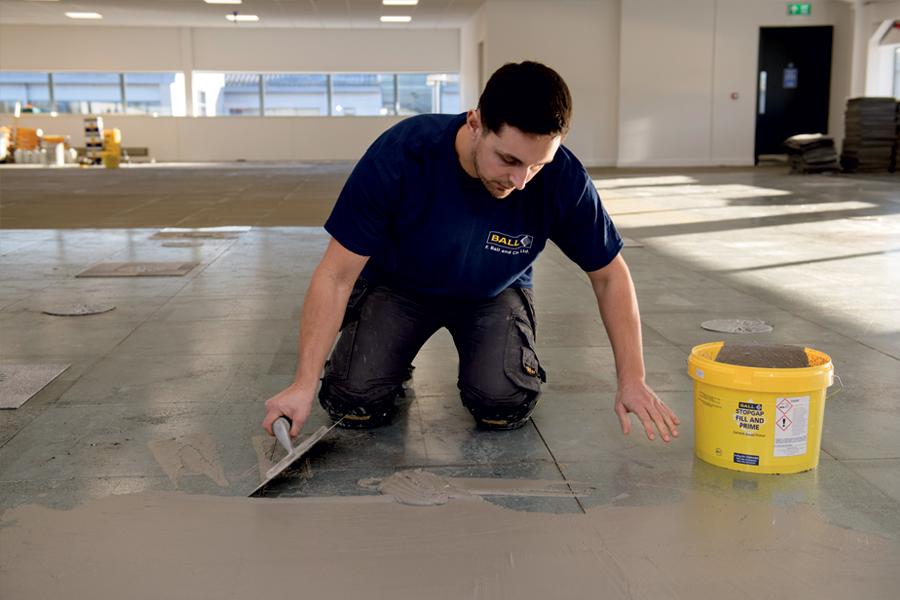CARPET tiles over raised access flooring is a common flooring combination in commercial environments. However, this type of project requires contractors to undertake particular subfloor preparation procedures to ensure the long-term performance of the installation.
Consisting of horizontal panels, typically made of metal or cementitious material, supported by adjustable ‘legs’, raised access flooring provides an elevated structural floor above a solid substrate, such as concrete, allowing space beneath for electrical wiring and other services found in modern commercial environments.
Carpet tiles are similarly practical in office environments; when installed using a carpet tile tackifier, individual tiles can be easily lifted and replaced when they become stained or worn – in walkways or areas occupied by chairs with castor wheels, for example.
Installing floorcoverings over raised access panels presents a few specific considerations, including the need to fill joints between panels before installing floorcoverings, remembering to prime the subfloor beforehand, and to select a levelling compound that can accommodate movement in the substrate. Before beginning, contractors should also check the height of the elevated floor is consistent, ensuring no safety hazards and a level base for the application of subfloor preparation products.
Filling the gaps
When installed, raised access panels have small joints between them. If a levelling compound is applied directly over the top of raised access panels, these gaps may result in weak points, which can cause the levelling compound to crack and lose its integrity. Therefore, the gaps must be filled before a levelling compound is applied and floorcoverings are installed to ensure the performance of the installation throughout its lifetime.
Priming is also important when working over raised access panels. When used over non-absorbent subfloors, such as metal panels, priming serves to promote the application characteristics of subsequently applied levelling compounds. When used over absorbent subfloors, such as panels made of cementitious materials, priming also serves to promote adhesion, as well as preventing levelling compounds from drying too rapidly, resulting in a reduced working time. It also helps prevent pinholing, caused by tiny bubbles resulting from the slow escape of air from the subfloor, which burst on reaching the surface, leaving small pinholes or craters as the levelling compound dries.
Two in one
Recently developed cement-based primers, such as F Ball and Co Ltd’s Stopgap Fill and Prime, are available that are designed specifically for use over raised access panels, which fill the gaps at the joints between the panels while priming the subfloor, reportedly saving valuable time. These cement-based primers have a thixotropic consistency, meaning they flow freely when stirred but set to a gel-like consistency on standing. This, says F Ball, enables the joints to be filled to minimise movement of the substrate. These primers are also reportedly suitable for use over raised access panels and substrates with well-bonded, waterproof adhesive residues prior to the application of a levelling compound.
Says F Ball: ‘Once the primer has cured, a fibre-filled levelling compound, such as F Ball’s Stopgap 700 Superflex, should then be applied to create a smooth base for the receipt of new floorcoverings. The product is reinforced with tiny fibres that maintain the integrity of the levelling compound, preventing cracks from forming as a result of minor subfloor movement caused by foot traffic or temperature fluctuations. It’s suitable for application over plywood and steel subfloors, including raised access panels, as well as concrete and sand/cement screeds.’
Carpet tile tackifiers
The company continues: ‘Once an applied levelling compound has cured, contractors can proceed to installing carpet tiles – Stopgap 700 Superflex will be ready to receive floorcoverings in as little as three hours when applied at a thickness of 3mm.
‘Installing carpet tiles using a carpet tile tackifier, such as F Ball’s Styccobond F41, ensures carpet tiles are held firmly in place when subject to lateral movements, such as everyday foot traffic and equipment being wheeled around, while allowing them to be easily lifted vertically if they need to be replaced later. The adhesive is solvent-free and, as testament to its ultra-low VOC emissions, certified EMICODE EC1 Plus.’
To use a carpet tile tackifier, contractors simply apply the adhesive evenly across the entire subfloor, using a roller or a brush, and allow it to dry to a clear, tacky film. The adhesive will then remain permanently tacky, enabling individual tiles to be removed.
Check compatibility
The company concludes: ‘It’s important to check the compatibility of particular floorcoverings, and adhesives. For this purpose, F Ball produces its industry-leading recommended adhesives guide (RAG), which lists adhesives recommended for use with over 6,000 floorcoverings produced by over 200 international manufacturers. It’s available as a free app or a printed booklet, and an interactive version can be found on the F Ball website.
‘Contractors can also contact F Ball’s technical service department, from 8.30am-5.00pm, Monday to Friday for advice on adhesive compatibility. Otherwise, they should consult manufacturer’s instructions.’
www.f-ball.co.uk
Please click to view more articles about
> F Ball <

